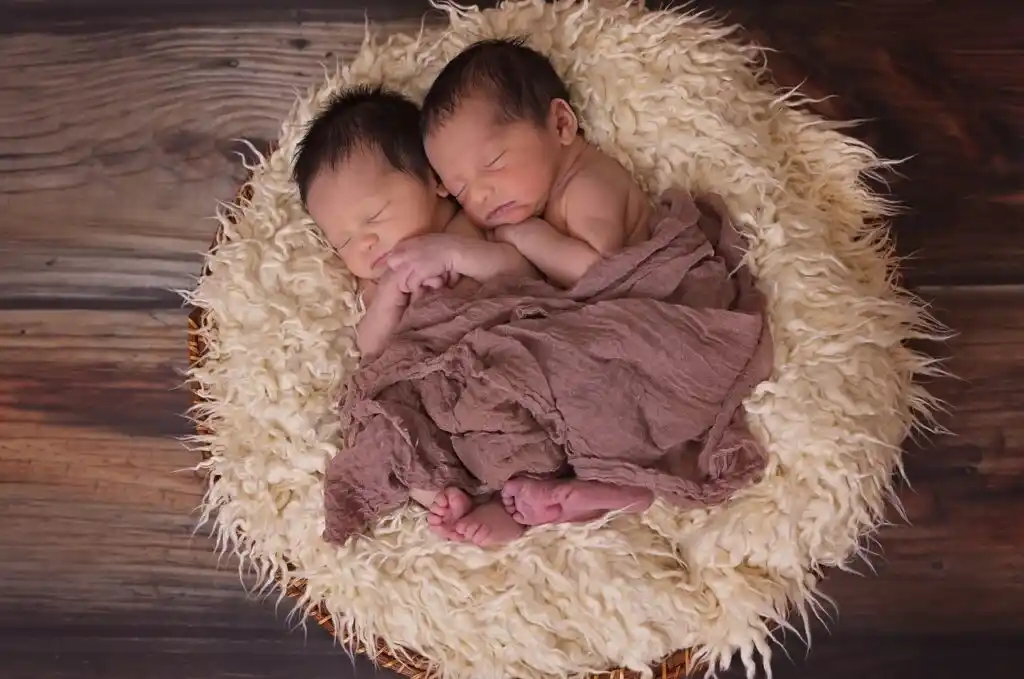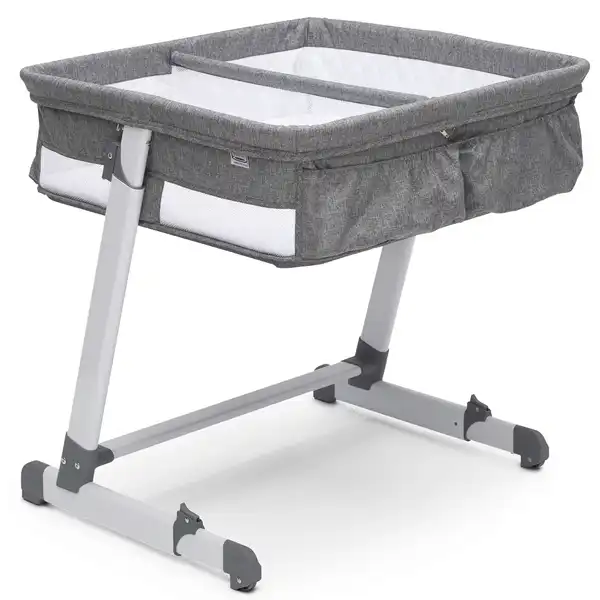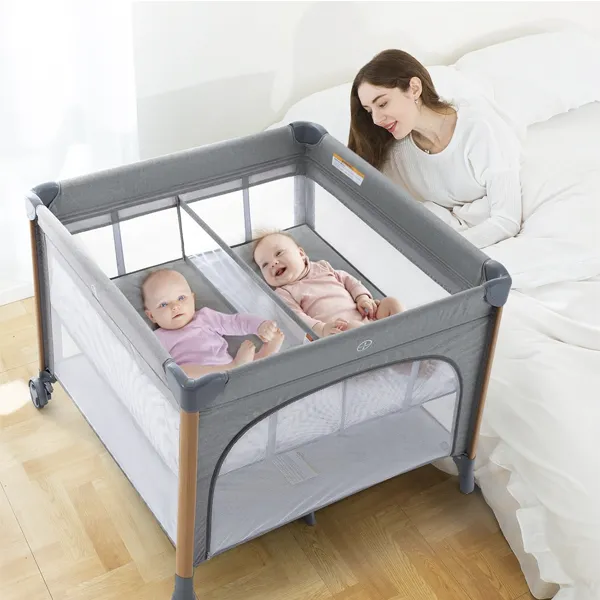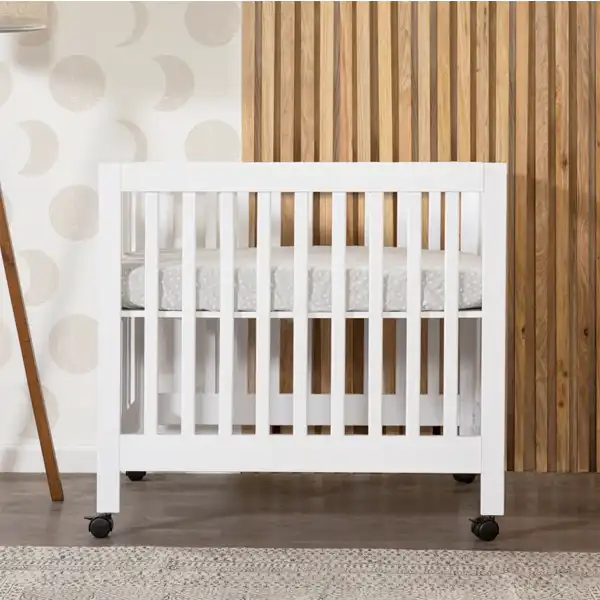
Taking care of newborn twins is an around-the-clock task. You have to manage nighttime feedings, diaper changes, and the need to soothe two fussy babies at the same time. Trying to do it all while still having some sort of slumber can be overwhelming. If you need solutions, co-sleeping is an option worth considering. Co-sleeping with twins can ensure your babies feel close and comforted while allowing you more rest.
If you want to learn how to co-sleep safely with twins, this guide provides everything you need. It covers everything, from the benefits of co-bedding to the best sleep setups to help your whole family get restful nights.
? If you’re unsure where to begin, check out our Complete Guide to Co-Sleeping With Your Baby to explore safe sleep options, setup tips, and expert-backed advice.
What Does Co-Sleeping with Twins Actually Mean?
When people hear “co-sleeping,” they often picture a baby in the parents’ bed. However, bed-sharing is not recommended, as it increases the risk of suffocation and other sleep-related dangers. That said, co-sleeping doesn’t have to mean bed-sharing, and it usually doesn’t, especially with twins.
Co-sleeping means sleeping in the same room as your babies, while they remain in a separate, safe sleep space.
For twins, co-sleeping can involve room-sharing with separate bassinets or cribs placed next to the parents’ bed. Another option is using twin bassinets or Playards with divided sleep spaces. A common co-sleeping practice for twins is also sharing the same crib. This practice is called co-bedding.
? To better understand the various safe co-sleeping setups, see our breakdown of the different types of co-sleeping, including room-sharing, side-car bassinets, and more.
What is Co-Bedding, and Is It Safe for Twins?
Co-bedding refers to twins sharing the same sleep surface, usually a crib (Not your adult bed!). It’s a common and recommended practice for twins in the newborn stage.
While bed-sharing (having babies in your bed) isn’t recommended by the AAP due to safety concerns, room-sharing with a safe twin co-bedding setup is both safe and beneficial when done right.
Why Co-Bedding Might Be a Great Option for Your Twins
- Twins are used to being close together from the womb. Sleeping side-by-side provides familiar comfort that can help them regulate their heart rate, temperature, and even breathing.
- Studies, including research from Dr. Helen Ball at the Durham Infancy & Sleep Centre, show that co-bedded twins often develop synchronized sleep patterns, meaning they wake and sleep at the same time, which is a huge relief for exhausted parents.
Dr. Ball also found that co-bedded infants mostly slept side-by-side in the first month. By the third month, parents began using other positions, like head-to-head or feet-to-feet, without any evidence that one arrangement was safer, more comfortable, or affected sleep quality.
? Co-bedding is safest if you follow the same safe baby sleep guidelines as for a single baby, and when twins have enough room to lie flat without rolling into each other.
Best Twin Co-Sleeping Arrangements for Newborns
The key is finding a setup that fits your space, helps you care for both babies during the night, and follows safe sleep guidelines. Here are some of the most practical and popular co-sleeping arrangements for newborn twins.
1. Twin Bassinet
Twin bassinets are designed with two babies in mind right from day one. They usually feature two separate sleeping areas within the same frame, often divided by a mesh panel. Many models let you remove or adjust the divider depending on what works best for you.
These bassinets are self-standing, so you can keep them next to your bed or move them around the house as needed. Some come with wheels for easy mobility, while others are designed to slide under your bed, making it feel like your babies are right beside you without actually sharing the same sleep surface.
There are quite a few options out there, but one that really stands out is the Simmons Kids By The Bed City Sleeper Bassinet for Twins. It combines functionality, safety, and convenience in a compact design that works well for most spaces.

Why parents love twin bassinets:
- Designed for safe co-sleeping with twins
- Babies sleep in fully separate space from parents
- Some models slide close to the bed for easier access
- Compact and easy to move from room to room
2. A Co-Sleeper Attached to the Bed
Think of this as a bassinet that attaches right to your bed—perfect for those middle-of-the-night moments. One side is either open or has a drop-down panel (not to be confused with the old-school drop-side cribs), so you can easily reach over to feed or soothe your babies without getting up.
The best part? Most co-sleepers, like the Ihoming model pictured below, can also stand on their own if you want to use them a little farther from the bed later on.

Twin co-sleeper benefits:
- Babies are just an arm’s reach away
- Easier nighttime feeding and comforting
- Encourages bonding while keeping a separate sleep surface
3. Playard for Twins
Some Pack ‘N Plays and Playards come with twin bassinet attachments that either rest on top or hang inside the main frame. Each baby gets their own cozy space, but they’re still right next to your bed. And once your twins outgrow those bassinets, you can simply take them out and use the Playard for naps, playtime, or even travel.
It’s a smart, space-saving option—especially if you’re looking for something that’s both budget-friendly and super versatile.

Why parents love it:
- Easy on the budget and does double duty
- Transitions from sleep time to playtime
- Ideal for travel or smaller rooms
4. Full-Size Crib
If you want something that lasts well beyond the newborn stage, a full-size crib might be the way to go. Many parents start out with both twins sharing one crib—either side-by-side or head-to-head, depending on what feels right for your babies.
? Tip: If your twins start waking each other, you can always move to two cribs later on.
Why parents love it:
- Roomy and grows with your babies
- Allows for co-bedding in the early months
- Cost-effective long-term solution
5. Two Separate Bassinets or Cribs (Side by Side)
If you’ve got the space and want each baby to have their own sleep area, placing two bassinets or cribs side by side is another great setup. It gives each twin their own space, which can mean better sleep for everyone.
There are plenty of compact options out there. Mini cribs like the Babyletto Origami are especially popular—they’re portable, stylish, and last longer than traditional bassinets.

Benefits of this co-sleeping arrangement:
- Mini cribs save space and grow with your babies
- Your twins have individual sleep spaces
- Encourages independent sleep habits from the start
Benefits of Co-Sleeping with Twins:
Moms with one newborn are exhausted, let alone two. Taking care of two newborns is not an easy job. However, a well-thought-out co-sleeping setup can make your nighttime routine much more manageable.
- Faster nighttime feeds: Having both twins nearby makes night feeds smoother and helps establish a more predictable routine over time.
- Quicker soothing: If one baby stirs, you can comfort them immediately, often before they fully wake and disturb their twin.
- Less disruption for you: No more climbing in and out of bed 6+ times a night. Everything you need is right within reach.
Final Thoughts: Yes, You Can Co-Sleep with Twins
While life with twins can feel chaotic, the right co-sleeping setup can help bring some peace back to your nights.
Whether you’re nursing, pumping, bottle feeding, or doing a mix of everything, having your twins close by in a safe and supportive environment can truly make a difference.
If you’re just getting started, take time to explore what feels best for your family. And remember—there’s no “perfect” way to co-sleep, but there is a safe and sustainable one.
You may also want to check out the benefits of co-sleeping to see how it can support bonding, breastfeeding, and better sleep for everyone.
And don’t forget to weigh the pros and cons of co-sleeping so you can make a well-informed decision that feels right for your family.
